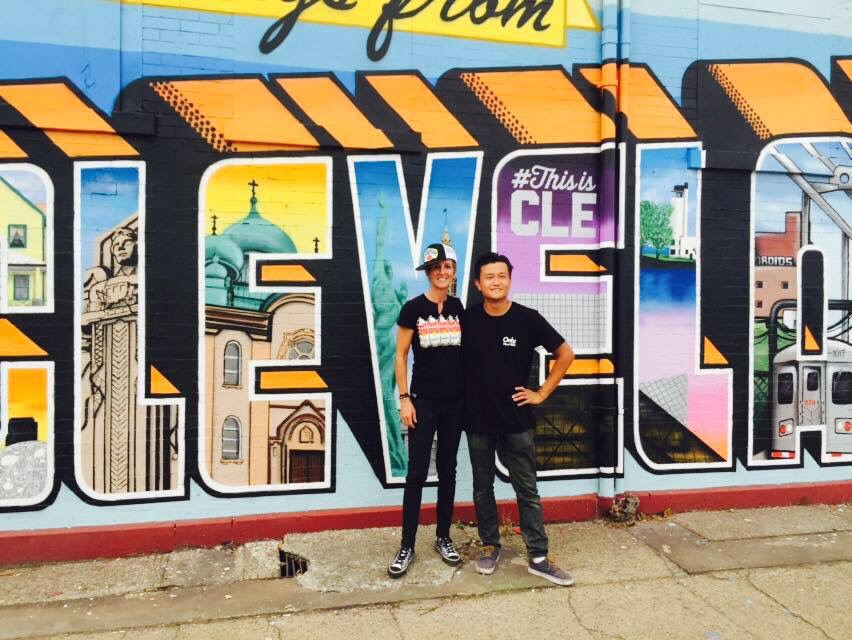
Sat 11/18 @ 6-11PM
Depending on one’s age, your first exposure to graffiti art may have been the opening credits to television shows such as Welcome Back Kotter in the 70s or The Fresh Prince of Bel-Air in the 90s. Or locally, riding the Rapid Transit to Tower City.
Whatever the case, the underground art movement has been steadily gaining steam for decades with Banksy becoming a worldwide phenomenon and a recent federal case in Brooklyn, New York in which jurors sided with street painters over a property developer.
In Northeast Ohio, local organization Graffiti HeART, which was founded in 2013, promotes graffiti and street art as an appreciated art form through aspiring and accomplished artists with charitable contributions that fund art education scholarships and urban development projects.
The nonprofit’s second annual Graffiti & Grapes scholarship benefit takes place Sat 11/18 at Cle Urban Winery with local urban artists, live music, auctioned live art, raffles, food and wine. CoolCleveland talked to Graffiti HeART president/founder Stamy Paul about the fundraiser and her unique organization.
CoolCleveland: Tell us about the Graffiti HeArt Scholarship Fund.
Stamy Paul: This is our annual fundraiser where our focus is raising funds for our scholarship program, which is a pre-college program at Cleveland Institute of Art. It’ll be our fourth year in providing scholarships to underserved high school students. We started in 2015, and since then we’ve been able to award 15 kids with scholarships, which is a two-week program including room and board at Cleveland Institute of Art.
CC: Who are the artists getting scholarships?
SP: Any kid that is basically high school age. They apply for the scholarship through the Cleveland Institute of Art and our board of directors once a year reviews the portfolios without any names. We make decisions based on our budget, as well as the portfolio quality, the level of talent and financial needs. They write an essay as to why they’d like to receive the scholarship and pursue art education.
CC: So what is Graffiti HeART?
SP: I’m an HR professional by day. A few years ago I was trying to explore something new or different to do in my life. I had a longstanding passion around graffiti through many travels I’ve had in my career. Years ago I tried to find an artist to do graffiti in my house. It was very difficult to find somebody in Cleveland. So I decided to turn this into a business, but also give back to the community. I created the organization Graffiti HeART with the mission to provide educational opportunities for underserved youth, but also help communities, private, public, corporate potential clients to illustrate their walls by finding artists and brokering projects. I basically contract artists based on the projects and price it out. A portion of the funds go to a scholarship and the rest goes to the artist, who gets recognized so the art form is truly appreciated.
CC: What is it about graffiti art that you like so much?
SP: The edginess, the fact it was very urban, underground. The fact that people either hated it or loved it. It wasn’t the status quo. I like the fact that it creates a lot of dialogue. If everyone loved it, I probably wouldn’t have gone down that path because it’s just too easy. The fact that it tells so many different stories and just like our society today, it’s politics. There’s one way and that’s the only way or there are people that can change their minds by opening their minds a little bit. I think that’s what the graffiti art form does to the whole landscape of art.
CC: It’s almost as if graffiti is the punk rock of the art world.
SP: Yeah, it is. It’s hip-hop, punk rock. Some of the interviews I’ve had, depending on the reporter, want to go right to the affiliation, or perceived affiliation, to the dark side. People think of it as illegal and gang-oriented, and in reality part of that world is associated with that, but there’s also an ever-growing above-the-ground element. It’s just a really fascinating aspect of our art world and our culture. And graffiti has been around since the beginning of mankind. It’s just interesting how urban graffiti in the last 30 years has evolved, but there’s still that visceral reaction, which is fine and without it probably would be as interesting.
CC: It sounds like in one sense you’re looking to discover Northeast Ohio’s Banksy?
SP: I guess. Banksy is almost to the point where it’s branded.
CC: Right, but Banksy has the same street origin.
SP: Yeah, exactly. I think part of the challenge is people say we don’t have those artists in Cleveland. And I’m like, “Yeah, we do, you’re just not opening the opportunities or your lens to go look for them.” We’re trying to provide opportunities to the artists that are interested to be able to showcase their landscape, their talent on certain walls or canvasses across the Northeast Ohio area or beyond. We’ve had a lot of fun being able to do that with some of the artists.